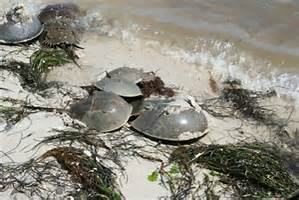Talk about weird and cool at the same time! The horseshoe crab is one of the oldest living species we have in the Gulf of Mexico. Fossils of this animal date back to almost 500 million years… this is before there was such a thing as fish! The separating of Pangea, the rise and fall of the dinosaurs, oh what stories these guys could tell! And they are here today, trudging along in the soft sands of estuaries along the Atlantic and Gulf coasts… but they seem to be on the decline. After all they have been through… they may be slipping away.
Actually, horseshoe crabs are not crabs at all. They belong to the same large group of animals the crabs belong to, Arthropods, but differ from true crabs in that they have fewer jointed legs and no antennae. They are actually more closely related to spiders and scorpions. There are 4 species remaining on Earth. Limulus polyphemus is the local variety with the other three living in Asia. They are tolerant of a wide range of environmental conditions. Huge swings in water temperature and salinity do not bother them. This is not surprising considering all of the environmental changes that have occurred since the species first appeared on the planet. They are scavengers, plowing through the soft bottom of estuaries, they feed on worms, mollusk, and whatever else their crop-gizzard system can breakdown. Their protective shell deters many predators; most horseshoe crabs meet their fate on the beach – where they must go to breed.
Breeding occurs all year in Florida. It typically takes place three days before and after the new or full moon. The smaller males come near shore and patrol for the oncoming females. As the females are intercepted the males will use their “hook” to hold on and the pair ride onto the beach. This usually happens at night (though not always) during the peak of a spring high tide. The female digs a small depression and deposits between 200 and 300 eggs, the male fertilizes them, and the female buries them. They leave the young on their own for a month, at which time the next spring tide arrives and the larva, which resemble trilobites, emerge. Many fall prey to shorebirds and many adults actually become stranded on the beach during nesting and die.
So why the population decline?
Well, they do tolerate large swings in environmental change, so increase temperatures, rainfall, salinities, do not bother them. Studies have shown that they are actually quite tolerant of many of the pollutants, including oil, we discharge into our bays – though mercury is a problem for the developing trilobite larva. Along the Atlantic coast the animals are collected for bait and the biomedical industry. Horseshoe crabs are used in eel traps and there are several medical uses for their blood. Some biomedical industries collect the crabs, remove some of the blood, and return them – but not all survive this. A big problem they are facing, and this would be closer to home, is the loss of nesting habitat. Seawalls, jetties, groins, and coastal development in general have disturbed nesting beaches.
That said, they seem to be making a comeback on Pensacola Beach. There have been sightings at both Big and Little Sabine. We would like to record where they are nesting in the panhandle. If you would like to help – the full moon for the next few months will occur on March 22, April 22, May 21, and June 20. The new moon will occur March 8, April 7, May 6, and June 4. If you do see a horseshoe crab please contact me at (850) 475-5230, or email at roc1@ufl.edu.
- Rattlesnakes on Our Barrier Islands; Part 1 Knowing the Snake - December 8, 2025
- Tips for Bear Encounters this Fall - November 10, 2025
- Pensacola Bay Invasive Species Summer Survey 2025 - November 3, 2025

